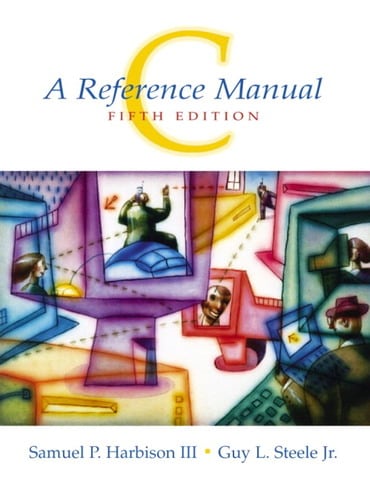
- Guy L. Steele |
- Samuel P. Harbison |
Title overview
For C programming courses found in departments of Computer Science, Engineering, CIS, MIS, IT, Business and Continuing Education.
This authoritative reference manual provides a complete description of the C language, the run-time libraries, and a style of C programming that emphasizes correctness, portability, and maintainability. The authors describe the C language more clearly and in more detail than in any other book.
- Coverage of the 1999 C Standard - The C language description now covers the U.S. and international revision to C, adding complex and Boolean types, flexible arrays, improved international support, and many other changes.
- Coverage of features in the 1998 C++ standard. Provides advice on how to write C code that is compatible with C++.
- Emphasis on writing clean C programs. Illustrates how to create programs that are maximally portable and reusable in both C and C++ environments.
- Chapter-end exercises—Detailed answers in the Appendix Allows students to apply what they're learned in each chapter.
- Coverage of the 1999 C Standard—Now included.
-
The C language description now covers the new U.S. and international revision to C, adding complex and Boolean types, flexible arrays, improved international support, and many other changes. Ex.___
-
- Coverage of new features in the 1998 C++ standard.
-
Provides advice on how to write C code that is compatible with C++. Ex.___
-
- Author's Website (www.CAReferenceManual.com or www.prenhall.com/harbison)—Includes example code, additional C resources, and the latest clarifications and additions from the standardization committees.
Table of contents
- I. THE C LANGUAGE.
- 1. Introduction.
- 2. Lexical Elements.
- 3. The C Preprocessor.
- 4. Declarations.
- 5. Types.
- 6. Conversions and Representations.
- 7. Expressions.
- 8. Statements.
- 9. Functions.
- II. THE C LIBRARIES.
- 10. Introduction to the Libraries.
- 11. Standard Language Additions.
- 12. Character Processing.
- 13. String Processing.
- 14. Memory Functions.
- 15. Input/Output Facilities.
- 16. General Utilities.
- 17. Mathematical Functions.
- 18. Time and Date Functions.
- 19. Control Functions.
- 20. Locale.
- 21. Extended Integer Types.
- 22. Floating-point Environment.
- 23. Complex Arithmetic.
- 24. Wide and Multibyte Facilities
- Appendix A. The ASCII Character Set.
- Appendix B. Syntax of the C Language.
- Appendix C. Answers to the Exercises.
- Index.
Author bios
From 1996-present Harbison led SDS infrastructure team and defined a software framework architecture across all TI DSPs and dev't tools, worked to make it fit with TI businesses, help negotiate alliances and acquisitions to make it happen. (Rollout and proudcts will appear in 1998.) Developed long-term vision in SDS and helped develop technology roadmaps. From 1995-96 as CTO Harbison set Tartan's technical direction. He defined and ran a new engineering organization and product development process that gave project managers more authority. He helped spearhead Tartan's long-term growth strategy by defining new products for C and Assembly programming on DSPs. Harbison managed the technical due diligence for TI merger. In 1992, he founded and directed the C/C++ Division, Tartan's first business unit and key to diversifying into commercial markets. Developed first PC-hosted products and first C++ product, for TI DSPs. Created a line of DSP math functions. Pioneered world-wide distribution channels using TI and 3rd parties. (Direct sales used elsewhere.)In 1990, Harbison founded a company, Pine Creek Software, funded by Digital Equipment Corp. to create a market for the Modula-3 programming language. Wrote the first Modula-3 textbook, exhibited at trade shows, wrote software, and published a newsletter. Still recognized as an authority, he was contracted by CRC in 1997 for a Modula-3 chapter in forthcoming Handbook of Object Technology.From 1982-1989, Harbison held various senior positions at Tartan, including Vice President. He led the software QA team & developed company-wide QA policies (1989). He managed several technology groups (1985-89). He was the project manager for Tartan's first commercial product (1984), and program manager for a contract with IBM to develop compilers for their RT PC (precursor to RS/6000). He designed and led development of Tartan's debugger (AdaScope). He developed the C compiler front end, and other internal tools (1981-1984). From 1980-82 Harbison was part of the SPICE research project at Carnegie-Mellon, which evangelized the concept of a "personal workstation" before most companies thought it was feasible. From 1974-80, he helped to develop the Hydra object-oriented, multiprocessor operating system, whose concepts were later used in the Intel 432 microprocessor.